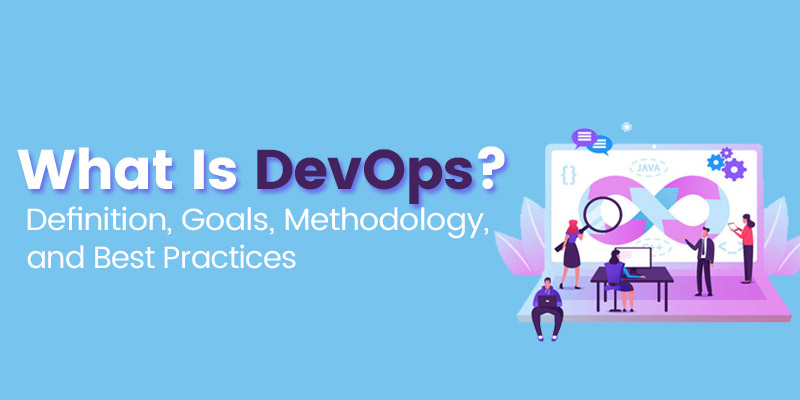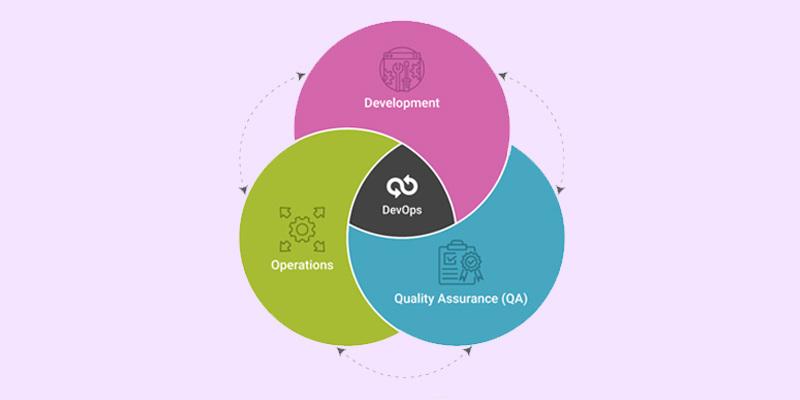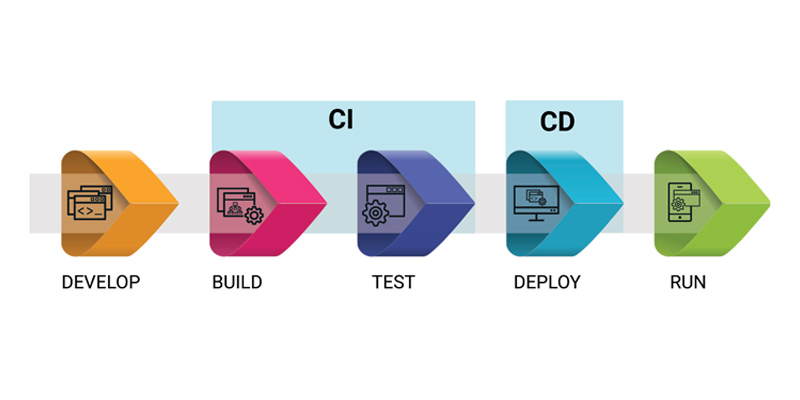
DevOps can be defined as combining tools and methods to create an organization that delivers applications and services faster than conventional software development processes. We can provide efficient value to customers by utilizing a DevOps methodology of processes and tools in business development.
In this blog, we shall discuss the Benefits of DevOps, Why DevOps, the Goals of DevOps, and the Objectives of DevOps.
If you want to become a DevOps Engineer, you can join DevOps Training in Chennai, which will help you have a better understanding of Use of DevOps, What is DevOps And How it Works, How DevOps Works.
What is DevOps?

The DevOps process combines the practices, tools, and cultural philosophy. Utilizing these methodologies can increase an organization's ability to deliver applications and services at high speed - Faster than companies employing conventional software development and infrastructure management methods in product evolution and improvement. As a result of this speed, businesses are better equipped to satisfy their clients and win market share.
Benefits of DevOps and Why DevOps
Teams for development and operations are no longer "siloed" under a DevOps framework. These two teams can often be merged into one group where the engineers work across the whole application lifecycle, from development and test to deployment and operations, and gain diverse skills that are not specific to a single role.
Throughout the lifecycle of an application, quality assurance and security teams may interact more closely with development and operations in some DevOps models. DevSecOps is the name given to a DevOps team when security is the team's top priority.
These teams employ techniques to speed up previously labour-intensive and manual tasks. They use a technological stack and tools to operate and develop apps with speed and dependability. Additionally, these tools assist engineers in doing independent tasks (such as provisioning infrastructure or distributing code) that previously required assistance from other teams.
To have a comprehensive understanding of DevOps methodology, you can join DevOps Training in Pondicherry and learn Benefits of DevOps, Why DevOps, Goals of DevOps, Linux Administration, Source Control Using Git, Continuous Integration Using Jenkins and Ansible.
Key Goals and Benefits of DevOps
Goals of DevOps
Setting innovative and difficult DevOps goals is essential for businesses to compete and succeed in the market, given the IT sector's rapid expansion and ongoing technological improvements. All effective DevOps programmes' primary objectives and leading concepts are listed below.
Ensures that teams collaborate effectively
Shared ownership is necessary for productive teamwork in any process. All parties involved in the development process ought to accept the shared accountability of the entire process.
The entire team should collaborate on any research, testing, or deployment projects. They ought to realize that their interests in the outcome are equal. The transfer of work from one team to another in the DevOps methodology is thoroughly defined and delineated. Because the collaboration between all the participating teams is streamlined, the entire development process is sped up.
Creates scalable infrastructure platforms
The main goal of DevOps is to build applications with highly scalable infrastructure that is sustainable. Scalable apps have become a must-have to meet the demands of the modern business sector. The scaling process should be reliable and entirely automated in an ideal world. As a result, the software can respond to any circumstance when a marketing campaign becomes viral. The app's scalability allows it to adapt to high traffic volumes while offering an ideal user experience.
Builds on-demand release capabilities
Managing software in a "releasable" form must be a top priority for businesses. Due to continuous delivery, the programme can add new features and go active at any point. DevOps wants to automate release management because it offers many benefits.
Automated release management is dependable, quick, and very consistent. Additionally, businesses can automate the release of new versions to their needs. Automated release management also includes comprehensive assessment tests, which are crucial for compliance.
Provides faster feedback
The process of providing timely feedback will be accelerated by automating tedious processes like testing and reporting. The development team can provide the revised version more quickly because it will be clear what needs to change.
The team can also better comprehend how the modifications it has made to the software lifecycle have affected things. Team members can collaborate better if they have explicit knowledge of changes.
The operations team and developers can improve the app's performance by working together and making smarter decisions in response to quick feedback.
If you want to understand the core concepts of DevOps, you can join DevOps Online Training and learn the benefits of DevOps, Why DevOps, Using Variables, templating, conditionals, loops and blocks.
Benefits of DevOps
DevOps helps organizations deliver added value to their customers. Here are some compelling benefits of DevOps.
More innovative work and faster release
DevOps enables your development team to release the necessary products swiftly. Faster delivery of products can put you well ahead of your competitors, which is crucial in today's cutthroat business environment. Businesses should be aware that an unautomated evaluation process will slow down the release process. Additionally, using various tools will result in context switching and increased expenditures. Consequently, DevOps can assist in resolving this problematic business situation.
Quick issue resolution
A quick feedback system can help you succeed in the commercial world, where precision and speed are crucial. DevOps reduces the time needed to resolve problems by enabling reliable connectivity. Important issues may be addressed with clear feedback, which will have detrimental effects down the road. Faster release pipeline unblocking is made possible by DevOps' open communication culture.
Better teamwork between teams
Greater flexibility and 24/7 team communication are made possible by DevOps. It provides a setting for distributed teams to integrate and work together. By removing the conventional departmental barriers between groups, a new sense of ownership is created, in which each team member believes they share equal responsibility for reaching delivery deadlines.
Employee happiness and engagement are improved as a result of this collaboration.
Fostering innovative mindsets
DevOps allows for easier application deployment phases than they would be using conventional techniques. This is because it streamlines the entire process, assures no quality issues, and enables prompt and effective release.
The development team now feels more at ease because everything is in order. As a result, it is capable of imaginative thought and can give the user greater value. Any company entity can benefit from having a creative development team.
An innovative approach expands the type of potential solutions and boosts the efficiency of addressing current issues. DevOps thus makes it simpler to increase an app's functionality.
Faster threat detection
The threat detection process will be accelerated by automated and continuous code testing. Identifying significant issues early on allows developers to address them more quickly. DevOps is crucial in preserving and improving an app's quality and performance.
Increased customer satisfaction
In today's world, it doesn't matter what kind of business one is in; customer happiness is key. DevOps is recognized for improving customer satisfaction by improving the consumer experience. Unhappy clients are never a sign of a successful company. An essential part of DevOps is feedback loops. End users can monitor the progress of app development at different stages due to these cycles.
Additionally, customers can offer suggestions for adjustments (if any) or provide feedback to make the app more customer-focused—feedback loops aid in keeping customers and developers on the same page because they are dynamic.
Additionally, DevOps speeds up software development, thereby cutting down on delivery time. This impacts the customer satisfaction rate positively.
Providing the much-needed edge
Companies need to ensure they can survive in the tough competition and adhere to their development plan. Your secret weapon for giving your company a competitive advantage is only DevOps implementation. Competitive advantage is crucial because it frequently determines whether or not an application will be accepted.
There are a few traits that set qualified businesses apart from average ones:
-
High-quality components
-
Faster and more frequent software releases
-
Increasing investment return
-
Observing constructive criticism
All the above requirements will be satisfied by DevOps, giving your company a significant edge over the competition.
If you want to become a DevOps engineer, you can join DevOps Training in Hyderabad and learn the Benefits of DevOps, Why DevOps, goals of DevOps, objectives of DevOps and use of DevOps.
DevOps Methodologies and Process
DevOps approaches and practices are entirely focused on automation and flexibility. DevOps' sole objective is to hasten the software process. The DevOps lifecycle is also focused on consistency and continuity. Continuous integration, planning, input, tracking, verification, delivery, and installation are the driving factors behind the production process.

The Process of DevOps
Development
The phrase "continuous development" refers to all iterative software development procedures. Everything involved in the development process is combined, including testing, integration, delivery, and deployment. There are connections between the continuous development strategy and its supporting plans.
Therefore, implementing them will enable enterprises to achieve faster output, decrease risk, and dramatically overcome bandwidth barriers.
Building and integration
The DevOps process flow frequently uses the technology known as continuous integration (CI). This makes sure that developers have access to the most authenticated codes.
The application development standard will inevitably rise due to developers having access to the most recent codes.
Multiple developers can confidently collaborate on the same source code due to CI.
As a result, it avoids time-consuming inefficiencies and saves money. It is safe to assert that continuous integration is an essential component of DevOps if you want to achieve speed and dependability.
Testing
The app must be tested and verified to ensure that code operates correctly. Continuous testing can also assist the team in finding hidden flaws and fixing them early on.
If bugs are fixed promptly, developing an app is finished in the allotted time.
Feedback and monitoring
It is essential to continuously monitor the development process because it maintains the system error-free. Furthermore, for continuous feedback, the monitoring process must be completely automated. You will receive real-time notifications from the automated system regarding any problems or failures in IT operations. An important factor in raising the system's overall legitimacy is timely feedback.
Delivery
Continuous delivery is the logical step following continuous integration (CD). This technique concentrates on swiftly releasing updates to end users. CD automates every step of the product release process to ensure consistent delivery.
With CI's basis of automated testing, new versions deployed without fuss with just a single click.
Deployment
Continuous delivery has an automated version called continuous deployment. Continuous deployment is usually preferable to continuous delivery for established DevOps enterprises.
During the deployment process, each update that has been approved is immediately made available to end users.
As a result, the release dates can be scheduled along with the deployment procedure. Furthermore, it also accelerates the feedback loop.
Join DevOps Training in Bangalore and learn Continuous Integration with Jenkins, Jenkins Architecture, Objectives of DevOps, Use of DevOps and How DevOps Works.
DevOps Best Practices

Implement an automatic dashboard
You may employ DevOps to its full potential with the aid of a digital dashboard. Because it functions as an unified tool, integrating the automated dashboard is crucial. It provides the operations team with a set of data that enables them to make better decisions. Additionally, the dashboard has a tangible graphical depiction that helps to clarify and interpret the information. As a result, corporations may view the entire process holistically.
Maintain a centralized unit
Numerous tools, including Docker, Splunk, Jenkins, etc., are available for DevOps. A centralised unit is therefore required for efficient operations. The development of all required tools will also be carried out by this unified organisation.
Additionally, the centralised unit is essential for improving agility across the board for the entire development team. Teams can share knowledge about helpful resources for the business organisation through a common hub. The team in charge may be tasked with developing various guidance programmes and keeping the tools up to date.
Build flexible infrastructure
Processes used for testing and developing applications should be adaptable enough to handle various exceptions. Changes to infrastructure can be handled by a wide variety of configuration management solutions. Failure infrastructure modes are regularly checked to guarantee consistency, if applicable.
The analysis of a component is automatically scheduled if a defect is discovered while it is being tested. Other components' performance is unaffected by this study because it runs in the background.
Executable files are routinely and automatically archived in the elastic infrastructure practice. All integration and release repositories are included in the archives here. As a result, it is simpler to retrieve the build in the event that a previous version needs to be updated. By doing this, the update process' timing can be significantly shortened (for instance, from hours to minutes). Now that you have understood the Benefits of DevOps, Why DevOps, Goals of DevOps, Objectives of DevOps, Use of DevOps and What is DevOps And How it Works. So, if you want to become a DevOps engineer, you can join the DevOps Training in Pune and learn the core concepts of DevOps methodology.